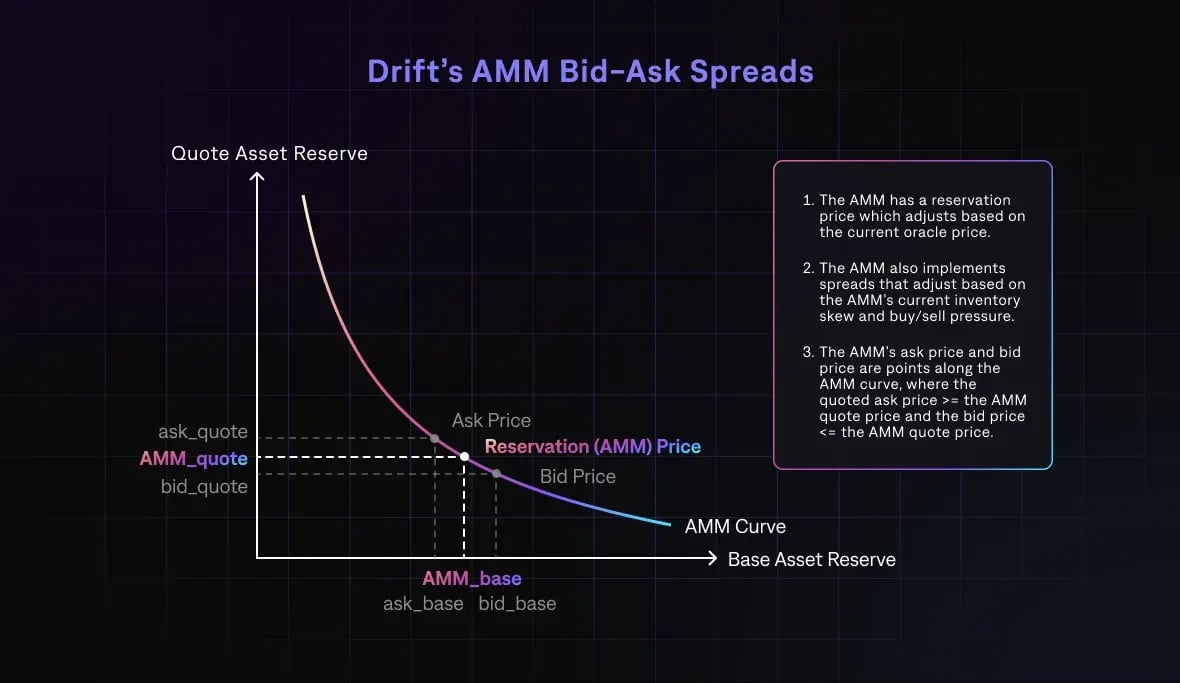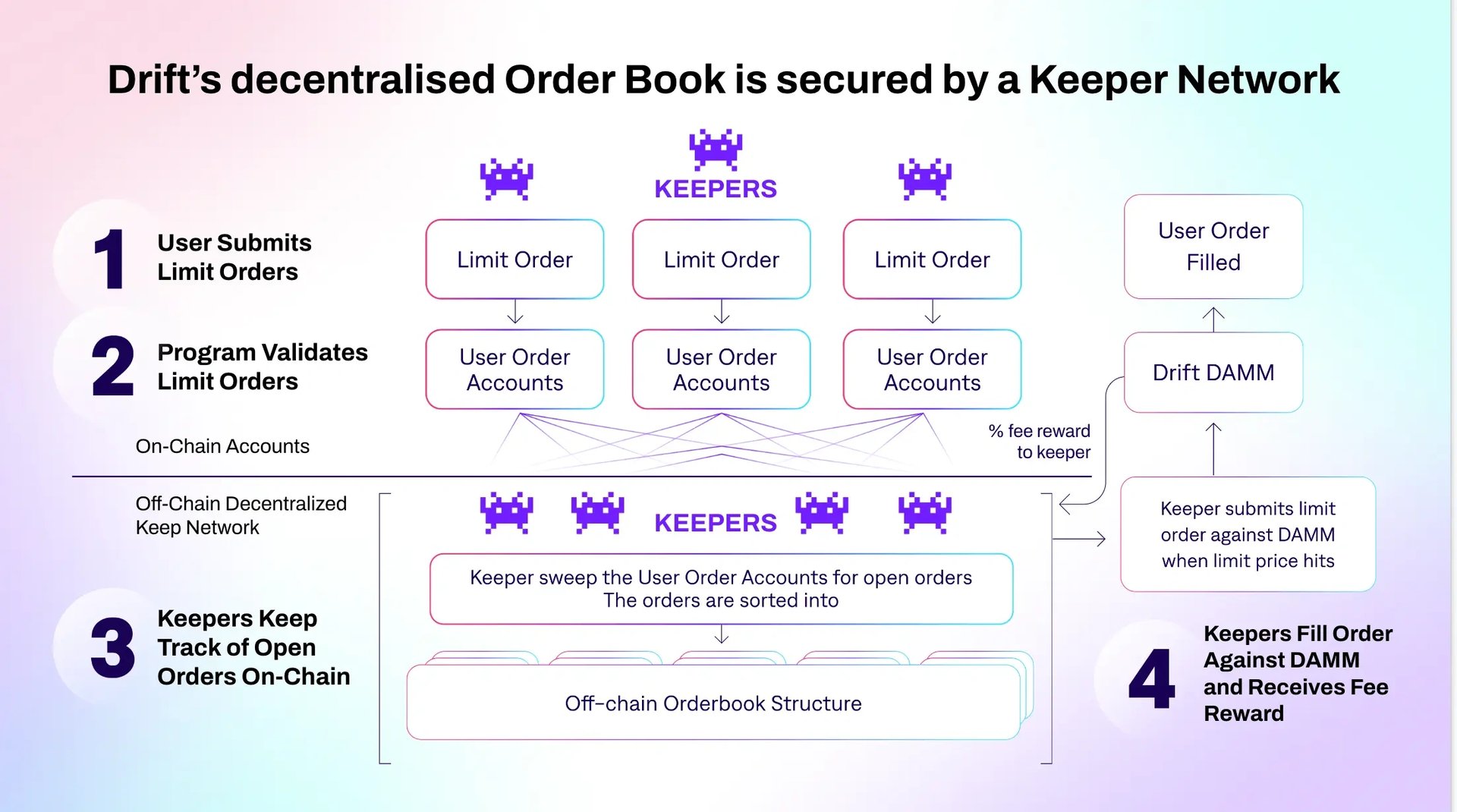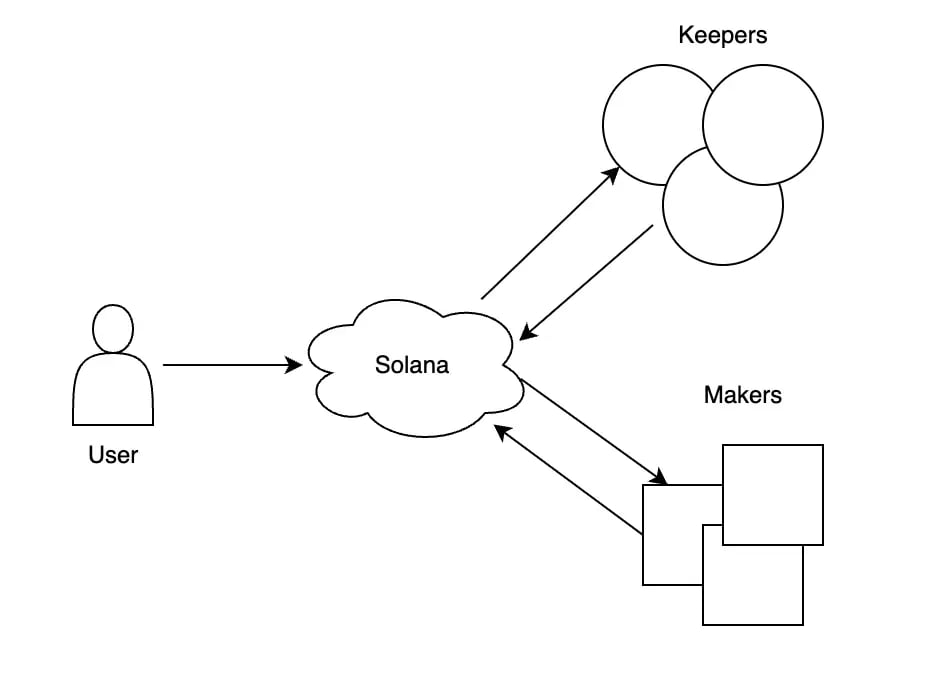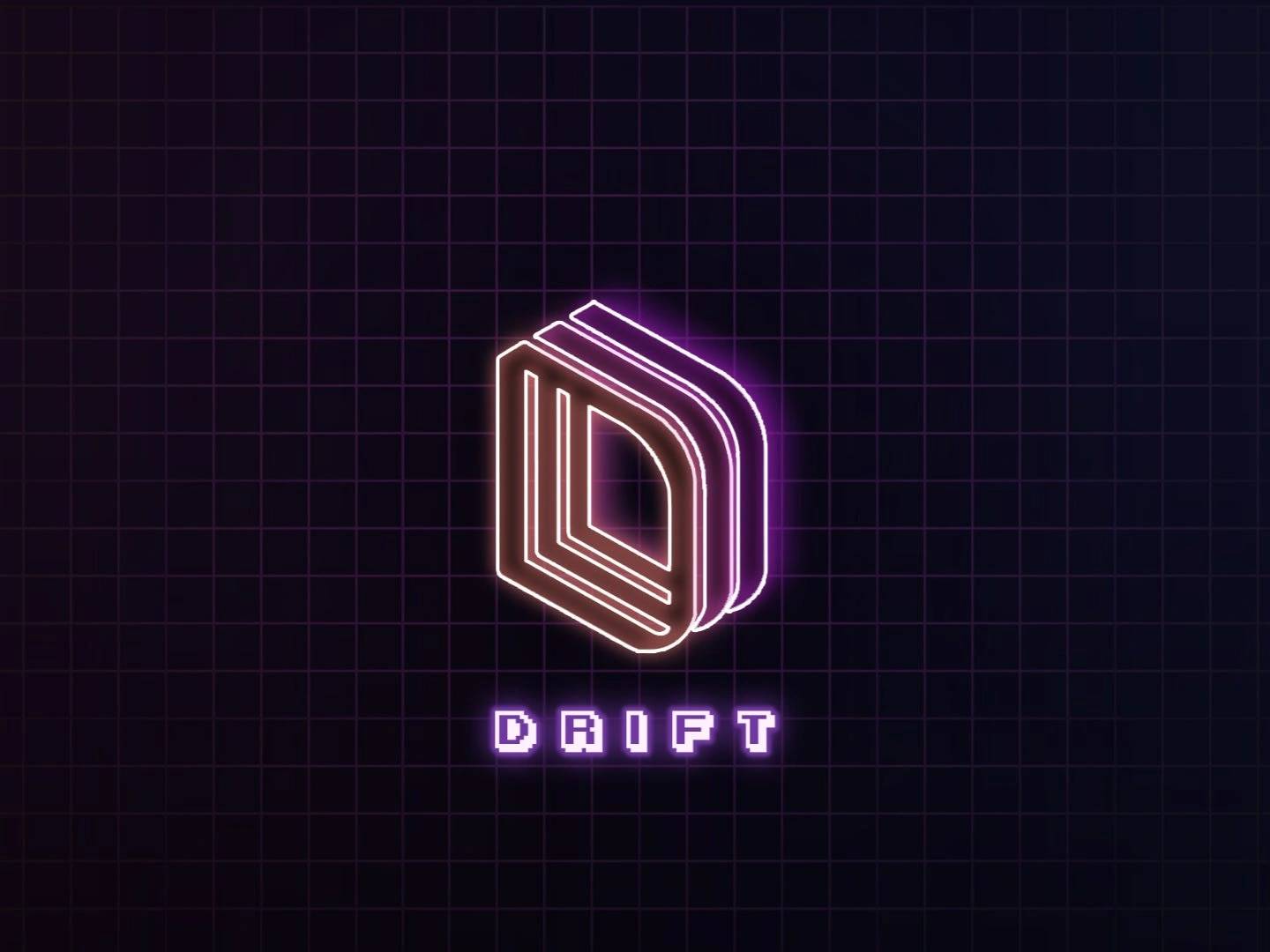위키 구독하기
Share wiki
Bookmark
Drift
Drift
**드리프트(Drift)**는 솔라나(Solana) 블록체인 기반의 분산형 거래 및 스테이킹 플랫폼으로, 무기한 선물, 현물 거래 및 유동적 스테이킹을 제공합니다. 온체인 주문장과 자동 시장 조성을 통합하여 효율적이고 지연 시간이 짧은 거래와 최적화된 자본 활용을 가능하게 합니다. [1]
개요
드리프트 프로토콜은 솔라나(Solana)(https://iq.wiki/wiki/solana) 기반의 탈중앙화 거래소(DEX)로서, 현물 거래, 무기한 선물, 대출, 차입 및 수동적 유동성 제공을 포함한 다양한 온체인 거래 활동을 지원합니다. 이 프로토콜은 유동성 메커니즘과 계산 효율 최적화를 결합하여 느린 거래 속도, 낮은 유동성 및 넓은 매수-매도 호가 차이와 같은 온체인 거래소의 일반적인 한계를 극복하는 것을 목표로 합니다.
거래에 대한 강력한 유동성을 보장하기 위해 드리프트는 세 가지 주요 메커니즘을 활용합니다. 시장 조성자가 실시간으로 주문을 이행하기 위해 경쟁하는 실시간(JIT) 경매, 외부 봇이 관리하는 탈중앙화 한도 주문장(DLOB), 그리고 다른 소스를 사용할 수 없을 때 백업 유동성 제공자 역할을 하는 가상 자동화 시장 조성자(AMM)입니다. AMM은 일정 곱셈 공식을 기반으로 작동하며 재고에 따라 스프레드를 동적으로 조정합니다. 동시에 키퍼 봇은 온체인 한도 주문을 관리하고 트리거하는 데 중요한 역할을 하며, 현재 시장 상황과 오라클 데이터에 반응합니다. 완전한 온체인 프로토콜인 드리프트는 모든 거래에 자체 보관 솔라나(Solana) 지갑이 필요하며, 스마트 계약 실행을 통한 투명성을 보장하는 동시에 탈중앙화 인프라의 고유한 제약을 받습니다. [2]
기술
드리프트 AMM

드리프트 프로토콜은 지속적인 온체인 유동성을 제공하기 위해 백스탑 자동화 시장 조성자(AMM)를 통합합니다. 드리프트의 초기 AMM 버전은 가상 AMM (vAMM) 모델을 기반으로 구축되었으며, 가격 승수(peg), 유동성 깊이(k), 수수료 수취인 수수료로 조성된 수수료 풀, 그리고 peg 조정, 유동성 조정, 상한이 있는 펀딩 지급과 같은 작업을 위한 동적 수수료 할당 등의 구성 가능한 매개변수를 특징으로 했습니다. [3]
현재 버전 2 AMM은 외부 백스탑 AMM 유동성(BAL), 농축 계수, 그리고 동적 스프레드 및 peg 메커니즘을 도입하면서 일정한 곱셈 공식을 유지합니다. 이러한 메커니즘은 재고 수준과 오라클 데이터를 기반으로 실시간으로 조정됩니다. AMM은 시장 상황에 따라 다양한 매수 및 매도 가격을 제시하고, 재고 불균형을 고려하여 스프레드를 동적으로 조정하며, 실시간 오라클 피드를 사용하여 예약 가격을 업데이트합니다. 이러한 설계는 탈중앙화된 실행을 유지하면서 더욱 신속한 가격 책정과 외부 시장 가격과의 더욱 긴밀한 일치를 보장합니다. [3]
탈중앙화 주문장
드리프트의 탈중앙화 주문장(DLOB, Decentralized Orderbook)은 오프체인 키퍼 봇(Keeper Bots)과 온체인 결제를 결합한 하이브리드 시스템을 통해 작동합니다. 이 키퍼 봇들은 주문장을 지속적으로 모니터링하고 특정 조건이 충족되면 주문 매칭을 촉진합니다. 여기에는 테이커 경매 매칭, 지정가 주문 실행, 드리프트의 AMM과의 상호 작용이 포함됩니다. 두 개의 매도자 전용 주문은 직접 교차할 수 없지만, 시장가 주문은 Just-in-Time(JIT) 경매를 통해 지정가 주문을 트리거할 수 있습니다. 그러나 AMM에 의해 체결된 매도자 주문은 리베이트 보상을 받을 수 없습니다. [5]
키퍼 봇들은 오라클 가격에 대한 최적의 실행을 제공하고 선착순 실행 순서를 준수하도록 인센티브를 받습니다. 강력한 키퍼 네트워크는 시스템의 성능과 사용성을 향상시키지만, 일반적인 트레이딩 봇이 키퍼 역할을 수행하더라도 프로토콜의 핵심 기능은 계속 작동합니다. DLOB의 설계는 누구든 키퍼 봇을 실행할 수 있도록 함으로써 탈중앙화를 우선시합니다. 또한 복잡한 주문 체결 로직을 오프체인에서 처리하고 필요한 경우에만 온체인 실행을 트리거함으로써 계산 효율성을 달성합니다. [5]
키퍼(Keeper)

키퍼 봇(Keeper Bot)은 드리프트(Drift)의 분산형 주문장의 필수 구성 요소로, 유효한 지정가 주문을 수집, 저장, 정렬 및 체결하는 역할을 합니다. 키퍼는 온체인에서 발견된 모든 미체결 주문을 개별 오프체인 주문장으로 컴파일한 다음 가격, 시간, 그리고 동일한 경우 포지션 규모에 따라 정렬합니다. 각 키퍼는 주문장에 대한 자체적인 뷰를 유지하여 주문 관리에 대한 분산형 접근 방식을 가능하게 합니다. [6]
키퍼는 트리거 조건을 적극적으로 모니터링하고, 사용자의 지정된 트리거 또는 지정가가 충족되면 교차 주문을 매칭하거나 AMM에 대해 지정가 주문을 체결하여 거래를 실행합니다. 키퍼는 서비스에 대한 대가로 체결된 각 거래에 대해 수수료를 받습니다. 이러한 경쟁 환경은 키퍼가 속도를 높이고, 매수자에게 우수한 가격 개선을 제공하며, 가장 오래되고 큰 주문을 먼저 처리하는 프로토콜의 원하는 순서에 따라 주문의 우선 순위를 정하도록 유도합니다. [6]
매칭 엔진

드리프트의 매칭 엔진은 분산형 경매 시스템을 사용하여 테이커 주문의 가격을 결정합니다. 각 주문은 경매 기간, 시작 가격, 종료 가격, 한도 가격 및 만료 타임스탬프를 포함한 구성 가능한 매개변수로 정의됩니다. 이러한 매개변수는 특정 시간 슬롯 수에 걸쳐 주문 가격을 결정하는 선형 가격 함수를 설정합니다. 경매가 완료되면 한도 가격이 주문의 유효 가격이 됩니다. 가격 매개변수는 고정 값 또는 오라클 가격에 대한 오프셋으로 설정할 수 있으므로 경매 중 실시간 오라클 변동에 따라 조정할 수 있습니다. 최대 타임스탬프는 주문의 만료 날짜를 지정합니다.
경매 단계에서 한도 주문은 테이커 주문만 수행합니다. 경매가 종료되면 "대기" 상태로 전환되어 명시적으로 "사후 전용"으로 지정되지 않는 한 메이커로서 유동성을 제공할 수도 있습니다. 테이커 주문은 세 가지 고유한 유동성 소스(백스톱 유동성 역할을 하는 프로토콜 소유 AMM), 기존 대기 한도 주문 또는 테이커 주문을 채우기 위해 시장 조성자가 특별히 제공하는 Just-in-Time(JIT) 유동성에서 채워질 수 있습니다. 주문이 접수되면 해당 트랜잭션이 Solana 네트워크에 브로드캐스트되고, 키퍼 봇과 시장 조성자는 경매 기준을 충족하는 유동성을 제공하여 주문을 이행하기 위해 경쟁합니다. 프로토콜은 최적의 가격 실행을 우선시하며, 모든 충족 시도에 대해 AMM 가격 책정을 대기 및 JIT 유동성과 비교합니다. [7]
특징
보험 기금
드리프트의 보험 기금은 프로토콜의 지급 능력을 보호하기 위한 중요한 안전장치로, 사용자 파산 및 자동 시장 조성자(AMM) 내의 적자를 충당하도록 설계되었습니다. 사용자는 USDC, BTC, ETH, SOL을 포함한 다양한 자산을 기금에 예치할 수 있습니다. 이렇게 함으로써 사용자는 프로토콜을 수동적으로 지원하고 생성된 청산 및 거래 수수료의 일부를 얻을 수 있으며, 각 자산 풀은 해당 통화로 표시된 부채를 지원합니다.
시장 변동성이 높은 기간에 특히 미실현 손실로 인해 사용자 계정 잔액이 0보다 낮아지고 적시에 청산할 수 없는 경우 기금이 활성화됩니다. 현물 시장의 경우 손실을 전액 충당하고, 무기한 시장의 경우 미리 정해진 상한선까지 충당합니다. 보험 기금은 프로토콜에서 징수한 수수료와 사용자의 기여금으로 유지됩니다. 기금 용량을 초과하는 손실은 사회화된 손실 메커니즘을 통해 관리됩니다. [8]
사회화된 손실
사회화된 손실은 시장의 전용 보험 기금이 미상환 부실 채무를 충당하기에 부족할 때 플랫폼 손실이 모든 사용자에게 비례적으로 분배되는 메커니즘입니다. 이는 레버리지 해소 과정에서 적자를 해결하지 못할 경우 발생하며, 영향을 받는 시장 내의 개방형 무기한 포지션과 대출자 간에 손실이 공유됩니다. [8]
격리된 기금
격리된 보험 기금은 표준 보험 기금과는 별개로 변동성이 매우 큰 시장을 위해 지정된 별도의 자본 풀입니다. 이 기금은 특정 시장에서 징수된 보험료로만 전적으로 조달되며, 해당 시장 내에서만 발생하는 파산 또는 레버리지 손실을 충당하는 데 사용됩니다. 격리된 기금의 수용력을 초과하는 손실은 그 후 사회화된 손실 메커니즘을 통해 처리됩니다. [8]
FUEL 충성도 프로그램
FUEL은 Drift의 온체인(on-chain) 충성도 프로그램으로, 플랫폼 전반의 사용자 활동을 추적하고 보상하도록 설계되었습니다. 참여자는 스테이킹을 포함한 다양한 활동을 통해 FUEL을 얻습니다 (28일 동안 스테이킹된 DRIFT 토큰 1개당 10 FUEL). 매수 주문 거래량(매수 주문 거래량 1달러당 1 FUEL) 및 매도 주문 거래량(매도 주문 거래량 1달러당 1 FUEL)을 발생시켜서도 FUEL을 얻을 수 있습니다. 이러한 수익은 모든 하위 계정 전반의 총 활동을 반영하여 사용자 계정에 지속적으로 추가됩니다. 스테이킹과 같은 시간 기반 수익은 28일 기간에 걸쳐 점진적으로 분배됩니다.
이 프로그램에는 특정 활동이나 시장에 대한 기본 수익률을 곱하는 활동 부스터(Activity Boosters) 기능도 있습니다. 예를 들어, SOL-PERP 매수 주문 거래량에 5배 부스터가 적용되면 부스터가 활성화되는 동안 거래된 1달러당 5 FUEL의 수익률이 증가합니다. 활성 부스터 및 해당 비율에 대한 정보는 Drift의 사용자 인터페이스에서 확인할 수 있습니다.
FUEL 캠페인 시즌 1에는 총 DRIFT 공급량의 최대 7.82%를 목표로 하는 이정표 기반 분배가 포함되어 진정한 거래 활동을 보상하고 허위 거래를 제외했습니다. 시즌 2는 2025년 6월에 종료되었으며, Drift는 사용자가 FUEL을 DRIFT 토큰으로 교환할 수 있는 향후 상환 옵션을 발표했습니다. 이러한 계획은 장기적인 커뮤니티 소유를 촉진하고 Solana DeFi 생태계 내에서 Drift의 입지를 강화하는 것을 목표로 합니다. [9]
B.E.T. 예측 시장
B.E.T.는 솔라나 기반의 자본 효율적인 예측 시장 플랫폼으로, 사용자가 실제 세계 이벤트에 대한 이진 결과(예 또는 아니오)를 예측할 수 있도록 합니다. 이 플랫폼은 USDC를 넘어 30개 이상의 다양한 담보 토큰을 지원하며, 전통적인 금융 시장에서 볼 수 있는 것과 유사한 고급 주문 유형을 제공합니다. [10]
B.E.T. 사용자는 지원되는 모든 담보 토큰에 대해 대출 이자를 얻을 수 있습니다. 또한, USDC가 아닌 담보 토큰에 대해서는 상대방이 손실(실현 또는 미실현)을 정산할 때까지 0% 이자로 마진 확장을 제공합니다. USDC로만 담보된 계정은 스테이블코인 디페깅 시나리오에서도 청산 위험이 없습니다. 각 계정의 마진 요건은 "최악의 경우 부채"를 기준으로 계산되므로 일반적인 오픈 주문 할당 시스템에 비해 자본 효율성이 향상됩니다. 게다가, 양방향 주문 또는 위험을 줄이는 주문을 하는 유동성 제공자는 추가 마진이 필요 없으며, 사용자는 미체결 주문에 대해 이자를 얻을 수 있습니다. [10]
DRIFT
DRIFT는 Drift 프로토콜의 기본 거버넌스 토큰으로, 활동적인 사용자에게 플랫폼의 미래 개발에 대한 소유권과 영향력을 부여하도록 설계되었습니다. DRIFT를 보유하면 Drift DAO에 참여하여 토큰 보유자가 프로토콜에 영향을 미치는 중요한 결정에 투표할 수 있습니다. 이 토큰은 탈중앙화된 거버넌스 프레임워크를 기반으로 하며, 중앙 집중식 제어보다 분산된 의사 결정을 우선시함으로써 프로토콜의 발전을 커뮤니티의 이익과 일치시키는 것을 목표로 합니다. [4]
토큰 경제학
DRIFT 거버넌스 토큰의 총 공급량은 10억 개로 제한됩니다. 이 토큰들은 5년에 걸쳐 배포될 계획이며, 다음과 같은 배분 계획을 가지고 있습니다: [4]
- 생태계 및 거래 보상: 43%
- 프로토콜 개발: 25%
- 전략적 파트너십: 22%
- 런치 에어드랍: 10%
거버넌스
드리프트(Drift) DAO는 드리프트 프로토콜의 발전을 관리하는 다중 분기 거버넌스 구조입니다. 드리프트 DAO 재단의 지원을 받으며, 토큰 보유자와 DAO 분기 간의 조정을 용이하게 합니다. 재단은 암호화폐 자문 회사인 웹슬링거(Webslinger)가 관리하며, 독립 이사 매트 쇼(Matt Shaw)가 이끌고 있습니다. DRIFT 토큰 보유자는 투표를 통해 거버넌스에 참여하여 프로토콜 개발, 위험 매개변수 및 생태계 자금 조달과 관련된 핵심 결정에 영향을 미칠 수 있습니다.
DAO는 세 개의 특수 분기로 구성됩니다. **렐름즈 DAO(Realms DAO)**는 프로토콜 전반의 개발을 감독하고, 보안 위원회를 선출하며, 토큰 경제 변화를 제안하고, 기여에 대한 보상을 할당합니다. **보안 위원회(Security Council)**는 프로토콜 위험 매개변수 조정, 프로그램 업그레이드 승인 및 거래 시장 추가 또는 제거 관리를 담당합니다. 메타DAO프로젝트(MetaDAOProject)와 공동으로 개발된 **퓨처키 DAO(Futarchy DAO)**는 의사 결정에 정보를 제공하는 조건부 시장 모델을 사용하여 생태계 프로젝트에 대한 자금을 할당합니다. 이 구조는 드리프트 생태계의 성장과 보안을 위한 분산되고 적응력 있는 접근 방식을 가능하게 합니다. [4]
파트너십
잘못된 내용이 있나요?
